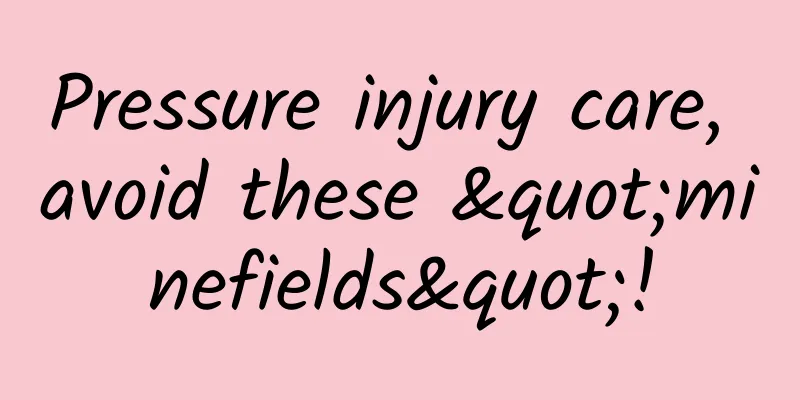Pressure injury care, avoid these "minefields"!

|
Pressure injuries are a common skin problem, especially among people who need to stay in bed for a long time or have limited mobility. This injury can lead to serious complications, causing pain and medical burden to patients. When caring for pressure injuries, we need to avoid some "minefields", such as friction and shear force, which is crucial to reducing the risk of injury. Here are some effective ways to help us prevent these "minefields" to protect the skin health of patients. I hope these methods can be helpful to you. The picture comes from the Internet Myth 1: Over-reliance on pressure equipment A common minefield when it comes to caring for pressure injuries is over-reliance on pressure-relieving devices. These devices, which include air mattresses, mattresses, and special care beds, are designed to reduce sustained pressure on specific areas of a patient. However, over-reliance on these devices can lead to problems such as: 1. Neglecting overall care: Over-reliance on pressure relief devices may cause caregivers to neglect the overall care needs of the patient. Mattresses or air mattresses may provide pressure dispersion, but they do not meet the other needs of the patient, such as staying dry, regularly repositioning, and skin cleanliness. Therefore, pressure relief devices must be considered as part of a comprehensive care plan rather than a single solution. 2. Different levels of risk: Pressure relief devices are not completely risk-free. Some devices may have the risk of leaking or malfunctioning, which may cause pressure to be concentrated in specific areas, thereby increasing the patient's risk of pressure injury. In addition, reliance on devices may make caregivers less sensitive to observing skin conditions and identifying potential problems early. Therefore, it is critical to avoid over-reliance on pressure-relieving devices. Instead, these devices should be combined with other care strategies, such as regular repositioning, keeping the skin clean and dry, and optimizing nutrition, to minimize the risk of pressure injuries. In addition, caregivers should closely monitor and assess the patient's skin condition so that any potential problems can be identified and addressed promptly. The picture comes from the Internet Myth 2: Home care minefield A pressure injury is a localized tissue injury caused by sustained pressure on the skin and underlying tissue. Home care plays an important role in preventing and managing pressure injuries, but there are some pitfalls to be aware of. 1. Keep your skin clean and dry: Cleansing your skin is very important, but too frequent cleaning and using harsh cleansers may cause dryness and damage to the skin. Proper cleaning and keeping the skin dry can prevent pressure injuries. 2. Turn over regularly: Long-term bed rest or sitting in an immobile position increases the risk of pressure injuries. Turning over regularly can reduce the time and pressure of skin pressure, which helps prevent the occurrence of pressure injuries. 3. Use a suitable mattress and cushion: Choosing a suitable mattress and cushion is an important step in preventing pressure injuries. Mattresses and cushions should have good support and pressure relief functions to reduce pressure on the skin. 4. Observe skin changes: During home care, you need to closely observe skin changes in the pressed area, such as redness, swelling, ulceration, etc. Once abnormalities are found, timely measures need to be taken, such as reducing pressure, keeping clean, and consulting a doctor in time. 5. Avoid wearing tight clothing and shoes: Tight clothing and shoes increase the risk of local skin pressure. Choosing appropriate clothing and shoes to avoid being too tight or too tight can help prevent pressure injuries. The picture comes from the Internet Myth 3: Over-massage 1. Skin Breakdown: Excessive massage may increase the risk of skin breakdown, especially on delicate or defatted skin. Excessive friction and pressure may cause breaks and ulcers on the skin surface. 2. Increased risk of infection: By over-massaging, the skin’s natural barrier function may be disrupted, making the damaged area more susceptible to infection by bacteria or other pathogens. Therefore, when doing skin care, you need to take the following measures to avoid over-massage: 1. Gentle touch: Try to use gentle touch and avoid rubbing or applying too much pressure. You can use your fingertips or palms to give gentle touch to help promote blood circulation. 2. Individualized Care: Each patient’s situation is unique, so care should be individualized to the patient’s specific circumstances. Depending on the type and severity of the damaged area, a medical professional can develop an appropriate care plan, including adaptive massage techniques. 3. Take regular breaks: When massaging the damaged area, take regular breaks. This helps reduce the continuous friction and pressure on the skin, giving the damaged area a chance to recover. The picture comes from the Internet Myth 4: Unreasonable stress management 1. Excessive stress reduction, that is, excessive relaxation of pressure on the damaged area in the hope of accelerating healing. However, excessive stress reduction may cause skin atrophy, slow blood circulation and insufficient nutrient supply, hindering the healing process of the injury. 2. Over-compression, that is, applying too much pressure to the damaged area. Excessive pressure can lead to impaired blood circulation, aggravate injuries and increase the risk of infection. Therefore, pressure management should be personalized and the patient's specific situation should be considered comprehensively to ensure that appropriate pressure is applied to promote healing. Another minefield is inappropriate wound covering selection. Choosing the right wound covering is essential to promote the healing of injuries. A common mistake is to choose a covering that is too large or too small. A covering that is too large may cause damage to the edges and concentrated pressure, while a covering that is too small may not cover the entire damaged area, increasing the risk of infection and further injury. 3. The covering material is not appropriate. Different wounds may require different types of coverings, such as dressing pads, gas permeable coverings, or moisturizing coverings. Therefore, when choosing a wound covering, you should consult a medical professional based on the patient's specific situation and wound characteristics to ensure that the appropriate covering is selected. Avoiding unreasonable pressure management and inappropriate wound covering selection is key. Since each patient's situation may be different, please ensure personalized and comprehensive considerations when implementing pressure injury care to minimize potential risks and promote healing. The picture comes from the Internet Myth 5: People who are prone to pressure injuries 1. People who stay in bed or sit for a long time: When the body stays in the same position for a long time, the skin is subjected to continuous pressure, which causes blood circulation to be blocked and easily causes pressure injuries. 2. Patients with vascular or neurological diseases: Impaired function of the blood vessels and nervous system may lead to insufficient blood supply or decreased sensation, increasing the risk of pressure injuries. 3. Elderly people: As they age, their skin elasticity and regeneration capacity weaken, making their skin more susceptible to damage. At the same time, the elderly often experience decreased physical strength and mobility, and staying in the same position for a long time also increases the risk of pressure injuries. 4. Severely obese people: Obesity will increase the pressure on local skin, especially when sitting or lying in bed for a long time, the pressure on the skin will be greater, which can easily lead to pressure injuries. 5. Patients with chronic diseases: Certain chronic diseases, such as diabetes, cardiovascular disease, and malignant tumors, can lead to poor blood circulation or decreased immune system function, increasing the risk of pressure injuries. By avoiding the risks of friction and shear forces, we can provide more effective care for patients with pressure injuries and reduce the incidence of complications. These simple but critical measures include correct positioning, use of low-friction sheets and mattresses, appropriate use of assistive devices, keeping the skin clean and dry, providing appropriate support, and training caregivers. By working together, we can minimize patient suffering, improve the quality of care, and bring patients a healthier and more comfortable life. Let us pay attention to the care of pressure injuries and work hard to avoid these "minefields" to bring patients a better future. |
<<: All medicines are poisonous. Which medicines are most harmful to the kidneys?
Recommend
What is the reason for endometrial thickening of 15mm?
The uterus is a unique part of the female body an...
Why do moles appear on the areola?
I believe that women's breasts are a part of ...
What are the consequences of abortion?
Speaking of abortion, it should be said that it i...
What are the pelvic floor muscle rehabilitation training?
The pelvic floor muscle strength is a very import...
What are the methods of confinement care?
It is necessary for women to take a confinement p...
What are the symptoms of gonococcal leucorrhea
A woman's normal leucorrhea is colorless, tas...
How to make honey apple cider vinegar? What are the tips for making applesauce?
Apple is a deciduous tree belonging to the genus ...
What is the liquid that women squirt?
Female squirting fluid refers to a substance secr...
The reason why it is not recommended to eat too many baked sweet potatoes in winter is probably unexpected (not to make you fat)
Walking on the street in winter, as long as you p...
How to eat Malatang correctly and healthily? Who can't eat Malatang?
I want to eat it every now and then. It's spi...
How to distinguish the symptoms of kidney deficiency and low back pain in women
Nowadays, many women suffer from kidney deficienc...
What are the benefits of foot massage for women?
As we all know, there are many acupoints on the s...
Acupuncture Clinical | Can rhinitis be cured by acupuncture?
01. Introduction The beginning of autumn has pass...
What causes cervical hypertrophy? What are the common symptoms of cervical hypertrophy?
Cervical hypertrophy is a symptom of chronic cerv...
How can women moisten the intestines and relieve constipation
Sitting still and not exercising will lead to con...









